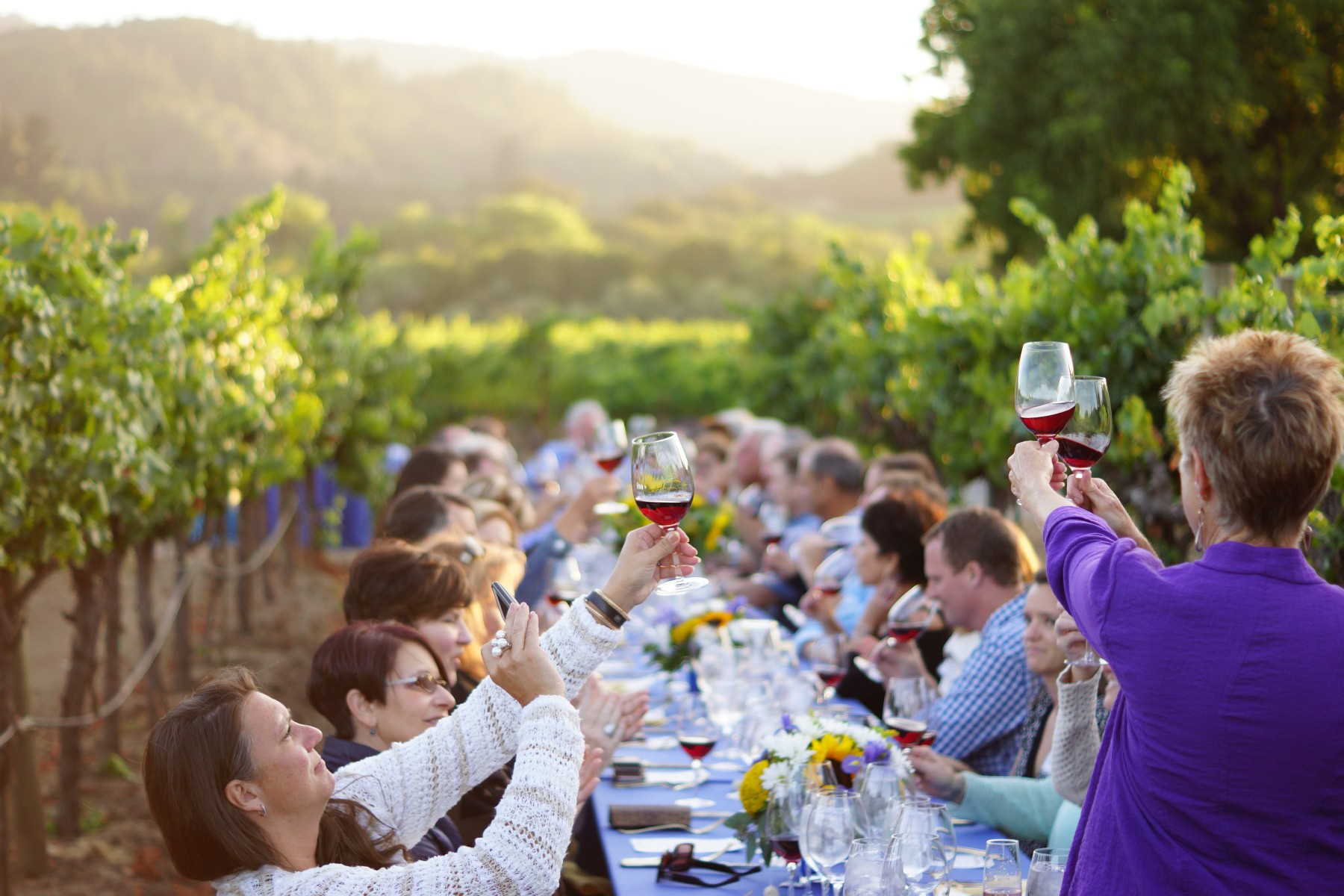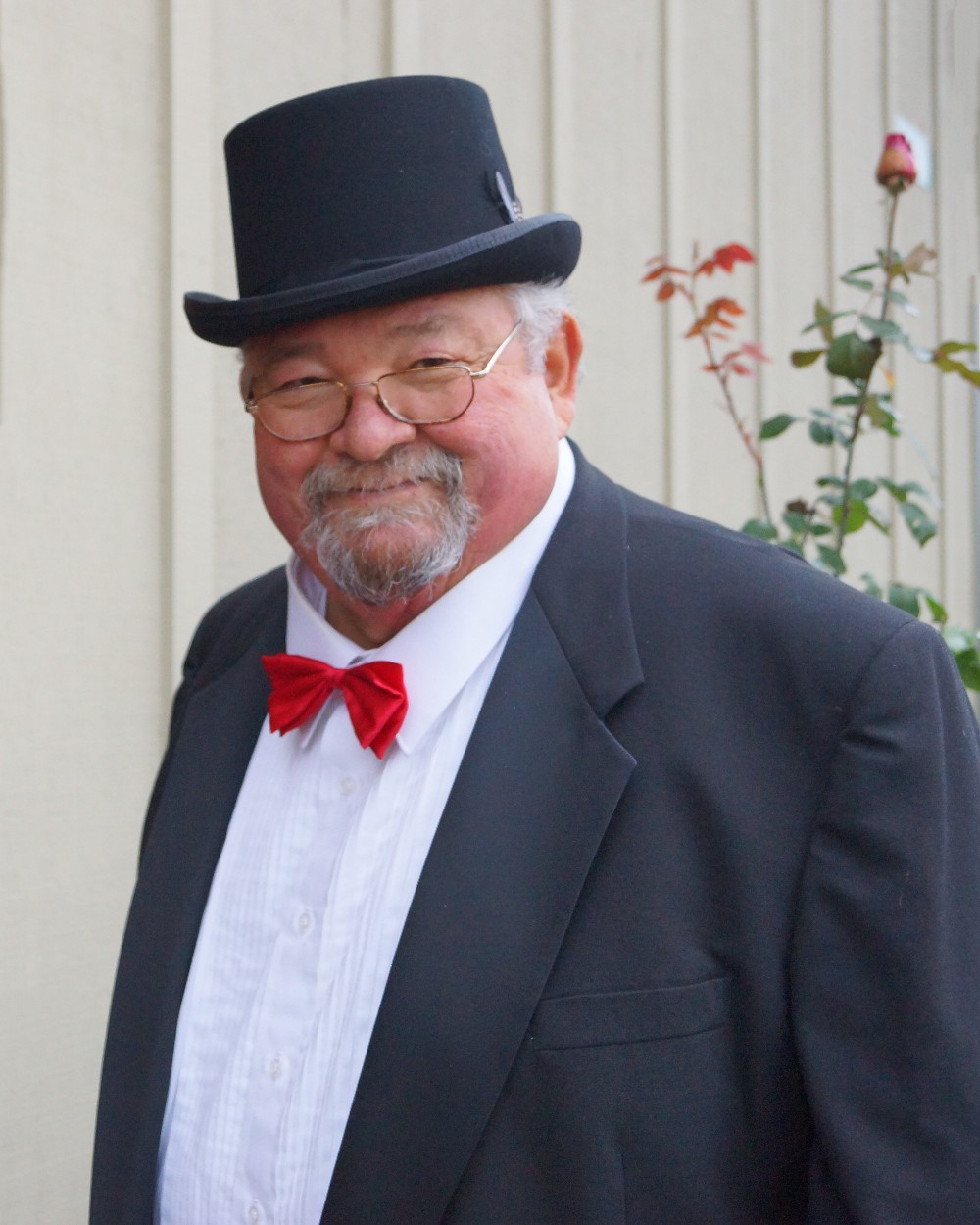News from Amista Vineyards
Amista Featured in Vineyard Specific Sonoma County Bubbles for New Years
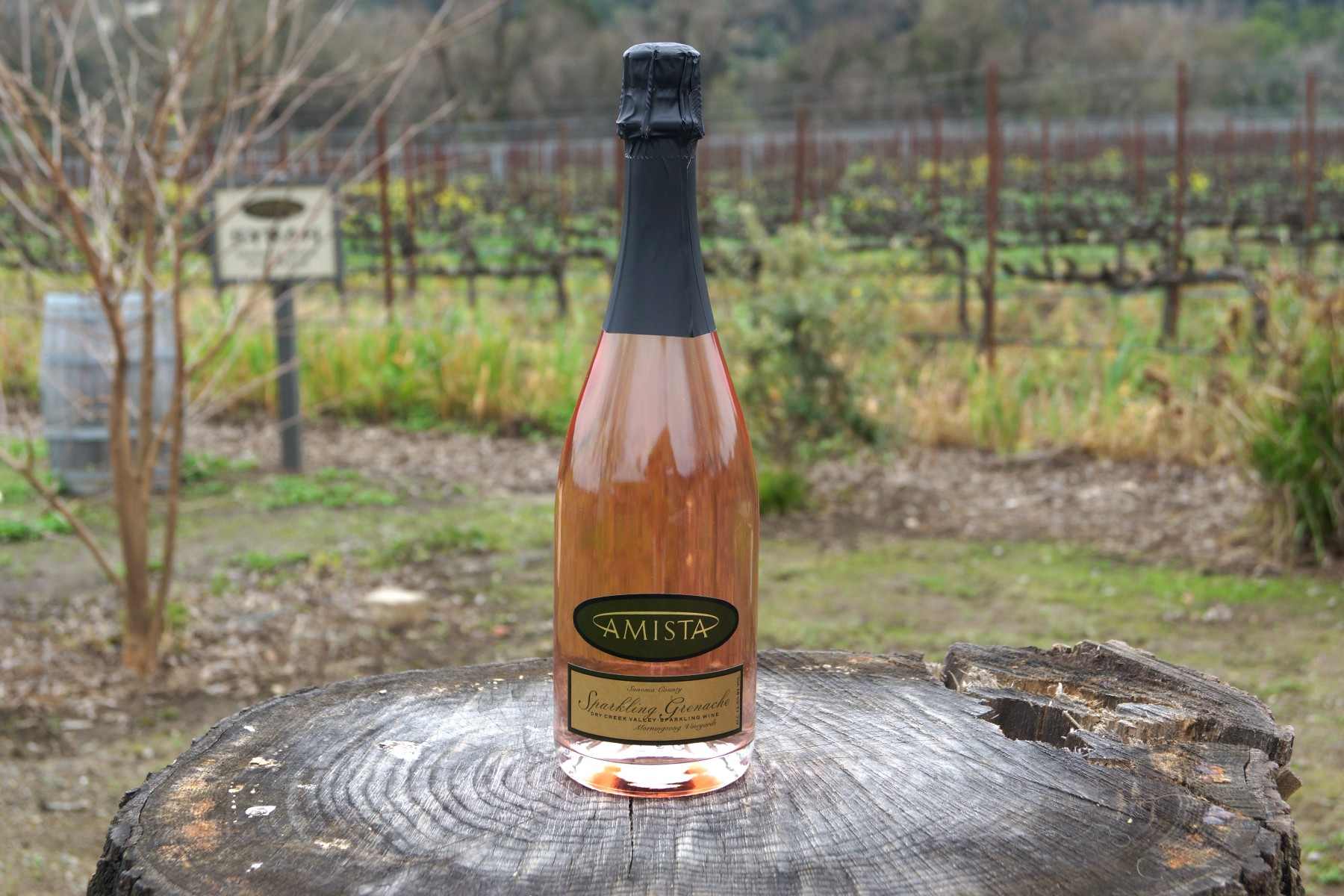
Amista Sparkling Grenache
Virginie Boone, a noted journalist who writes about Napa and Sonoma wines for publications like Wine Enthusiast, the New York Times and Food and Wine, featured a wonderful list of vineyard specific bubbles for the holidays. We are honored that our Amista Sparkling Grenache was among the wines she recommended. Boone describes it as, “Made in a Brut Nature style from estate vineyards, this is a bright, fruit-forward and fun bottling that remains balanced in the glass.”
Exploring Vineyard Designate Sparkling Wines
It is refreshing to see a list of vineyard specific sparkling wines. Virginie writes a weekly series called “The Good Stuff” for the Sonoma County Winegrowers, so it is fitting to celebrate the vineyards where the grapes are grown. Boone encourages people to explore sparkling wines from Sonoma County saying, “Take that exploration up a notch by choosing a vineyard-designated sparkling wine, which’ll highlight who farmed the grapes and where.”
Check out her recommendations at Vineyard-specific Sonoma County Bubbles for New Year’s on the Good Stuff blog by Virginie Boone.
Non-traditional Grapes Varieties for Sparkling Wines
Our Sparkling Grenache is the only wine on the list not made from Chardonnay or Pinot Noir grapes. Those two varieties are the traditional grapes used most often in Champagne and in many sparkling wines around the world.
At Amista, we love to create non-traditional sparkling wines using the Rhône varieties grown on our estate, including Syrah, Grenache, Mourvèdre and blends of the three. We also honor tradition with our Amista Blanc de Blanc, made from 100% Chardonnay grapes, which we’ve made every year since 2011.
The Debut of Amistara, a Sparkling Blanc de Blanc to Celebrate 20 Years
In 2024 we will debut a second Blanc de Blanc called Amistara to celebrate Amista’s 20th anniversary. Amistara is a vineyard designated wine from our own estate, Morningsong Vineyards. It is even more special because it comes from one small block of Chardonnay growing on the famous Wente clone root stock.
Amista Vineyards Sparkling Wine and Caviar Featured in Holiday Gift Guide
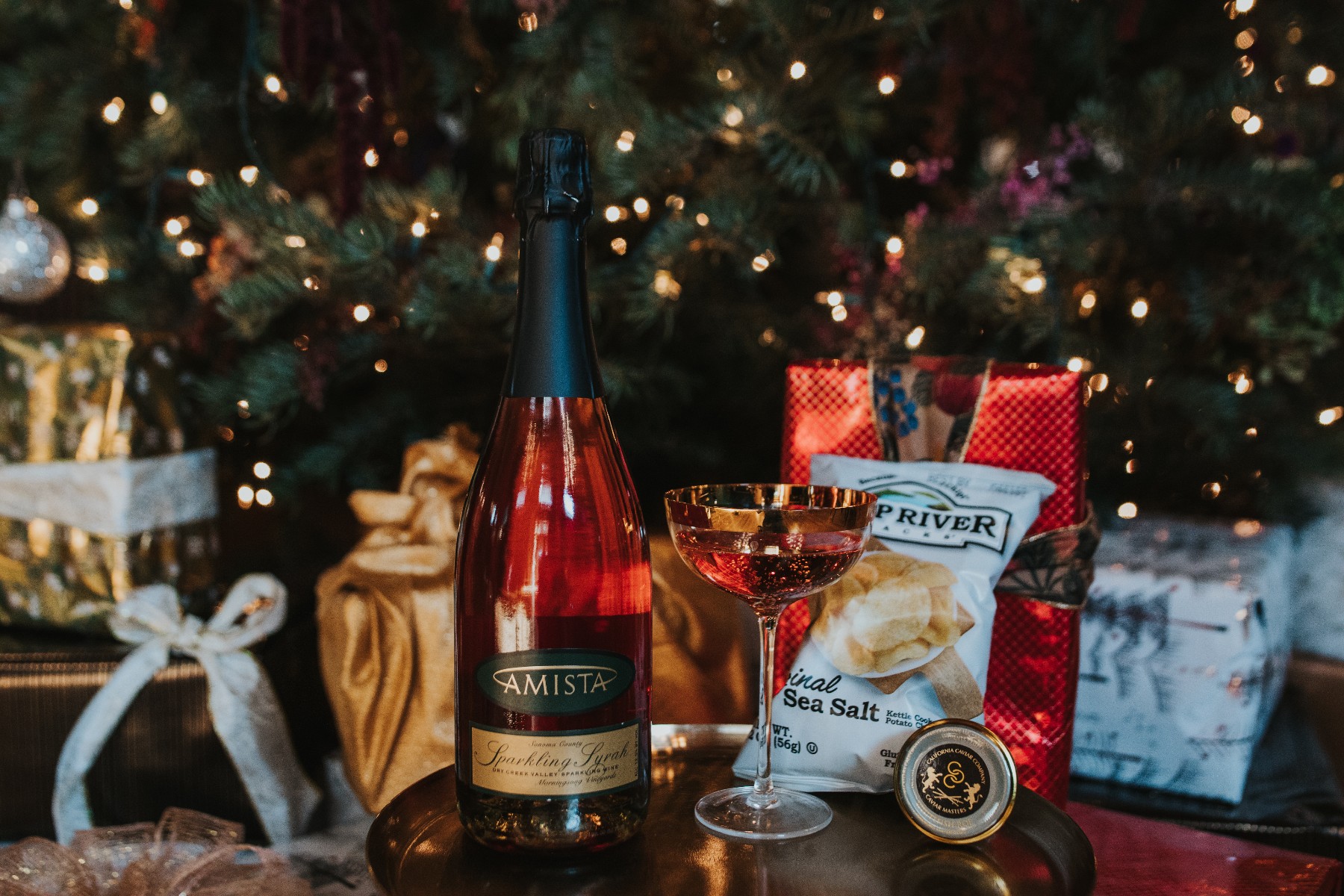
Amista Vineyards Sparkling Wine and Caviar - The Perfect Holiday Gift
The Amista Sparkling Wine and Caviar Tasting was showcased in the annual Holiday Wine and Gift Guide for 2023 by the Jet Setting Fashionista, declaring, “Amista Vineyards produces some stunning Sonoma Sparkling Wines which are perfect for holiday gifting or just to enjoy day to day. My favorite is the Blanc De Blanc, which is perfect year-round.” JSF goes on to say, “for Christmas what’s more festive than their Sparkling Syrah?”
A caviar tasting has become a delicious way to make an Amista wine tasting even more special. It includes caviar from the California Caviar Company, crème fraiche and crispy sea salt kettle cooked potato chips.
Sparkling Syrah – The First Sparkling Wine from Amista
Since launching Amista in 2004, we made Syrah from our estate Morningsong Vineyards located in the heart of Dry Creek Valley just outside the town of Healdsburg. In 2005 we ended up making a Rosé of Syrah. It wasn’t exactly planned but turned out to be a happy accident.
Amista founder Mike, was supervising the pick of the Syrah in the middle of the night and in his enthusiasm, picked more than originally planned. It fit in the tank at the winery, but it was too full to allow for the process of fermentation. So, Mike had some of the juice put in barrels with the plan to blend it back with the rest of the Syrah after fermentation was complete. All it took was one taste to decide to bottle the juice and make our first rosé. It was a big hit.
In 2007, our winemaker asked if he could have some Syrah rosé juice to make a sparkling wine in his winemaking class using the traditional Methode Champenoise. We thought that was a great idea, especially if we could taste it. It was delicious, and in 2008 we decided to try making our own Sparkling Syrah. It turned out to be both luscious and beautiful – a glittering raspberry color – with tiny pink bubbles. We’ve been making it ever since and this uncommon sparkling wine has developed a cult following.
What to Pair with Amista Sparkling Syrah
Sparkling Syrah is wonderful for the holidays. It looks festive on a holiday table and pairs beautifully with the wide array of holiday dishes – roast turkey, ham, stuffing, cranberries, and sweet potatoes.
It’s also a great choice for a barbecue. It can stand up to ribs, sausages, and pork, and it offers a refreshing counterpoint to the richness of grilled meats or the perfect companion to barbecued shrimp.
Our Sparkling Syrah is surprisingly versatile. It goes spicy pizzas, a variety of appetizers, like cranberry and goat cheese in phyllo cups, as well as desserts like a creamy panna cotta with a raspberry coulis. And it’s perfect with spicy stir fry’s, Thai dishes, curries, and sushi.
Check out the Holiday Wine Gift Guide 2023.
Raising our Glass to Mike Farrow
Mike Farrow (1943 - 2023)
It is with great sadness that we announce the death of Amista Vineyards co-founder Mike Farrow, who died at the age of 80 in hospice care on December 4, 2023. His wife and Amista co-founder, Vicky shared details of Mike’s health challenges in a blog post in August. Ultimately, he never fully recovered after contracting sepsis from an injury sustained during a fall earlier this year.
We will greatly miss his sense of humor, his warmth, and constant determination to find a way to turn challenges into creative opportunities. He was an inventive home chef and baker who enjoyed wine country living and sharing those simple pleasures with friends. We will always remember him so dapperly dressed in his tuxedo and top hat each year at our Sparkling Soirée.
Mike’s wife Vicky, Amista’s CEO, will continue to lead the winery and carry on the spirit of Amista with the help of their dedicated team. She invites those who knew Mike to come by the tasting room anytime to raise a glass in his honor.
It was Mike’s inspiration that led to the founding of Amista Vineyards with Vicky in 2004. The journey actually started in 1994 when he decided to plant 150 vines on their property in Saratoga, California, to solve a landscaping problem. Shortly thereafter, he started dabbling in making wine in their garage. Mike immediately fell in love with the alchemy of turning grapes into wine and sharing this love with others, including the many friends along the way who encouraged Mike and Vicky to found Amista. The winery name, as anyone who’s ever been to the tasting room knows, roughly means “making friends” in Spanish.
Mike retired to “Winemaker Emeritus” with the appointment of Ashley Herzberg as winemaker in 2011. Their friendship and collaboration over the years resulted in the expansion of Amista’s wine program, notably the planting of additional Rhône varietals and the creation of Mike’s favorite wine, a blend of Grenache, Syrah and Mourvèdre, which they named Tres. Ashley and Vicky ultimately persuaded Mike that they should launch what has become a growing portfolio of estate sparkling wines.
Next year will mark the 20th anniversary of Amista’s founding. It was always a great source of pride for Mike to have built a business that created friendships and connections, including helping to nurture career paths for many team members over the years.
Mike was born in 1943 in Boulder, Colorado, as the sixth in a line of eight boys to parents Mason, a chemist and Elizabeth, a teacher. After attending the University of Colorado Boulder and then going on to earn a PhD in chemistry from Oklahoma State University, he performed research and taught at the University of Utah, and then joined IBM as a research chemist. While at IBM he met Vicky, and they were married in Boulder in 1983. Mike is survived by his wife, his brothers Joe, Bob, and Tom, brother-in-law Chuck Goudge and many nieces and nephews, and his faithful shelties Torin and Dylan.
A celebration of Mike’s life is planned for the spring, and his legacy will be honored throughout 2024 as part of our 20th anniversary celebrations. We will share more details early next year, in the meantime, please come by for a special pour of Tres in his honor.
Cheers to you Mike, we tip our hats to you!
- Vicky and the Amista Team
Mike and Vicky have been longtime supporters of Sonoma County’s Career Technical Education Foundation. In lieu of flowers, donations can be made to support the foundation’s work to provide hands-on, career-connected learning opportunities to local students at https://ctesonomacounty.org/support-us/
The True Meaning of Amista
What I Discovered at the Vineyard Dinner
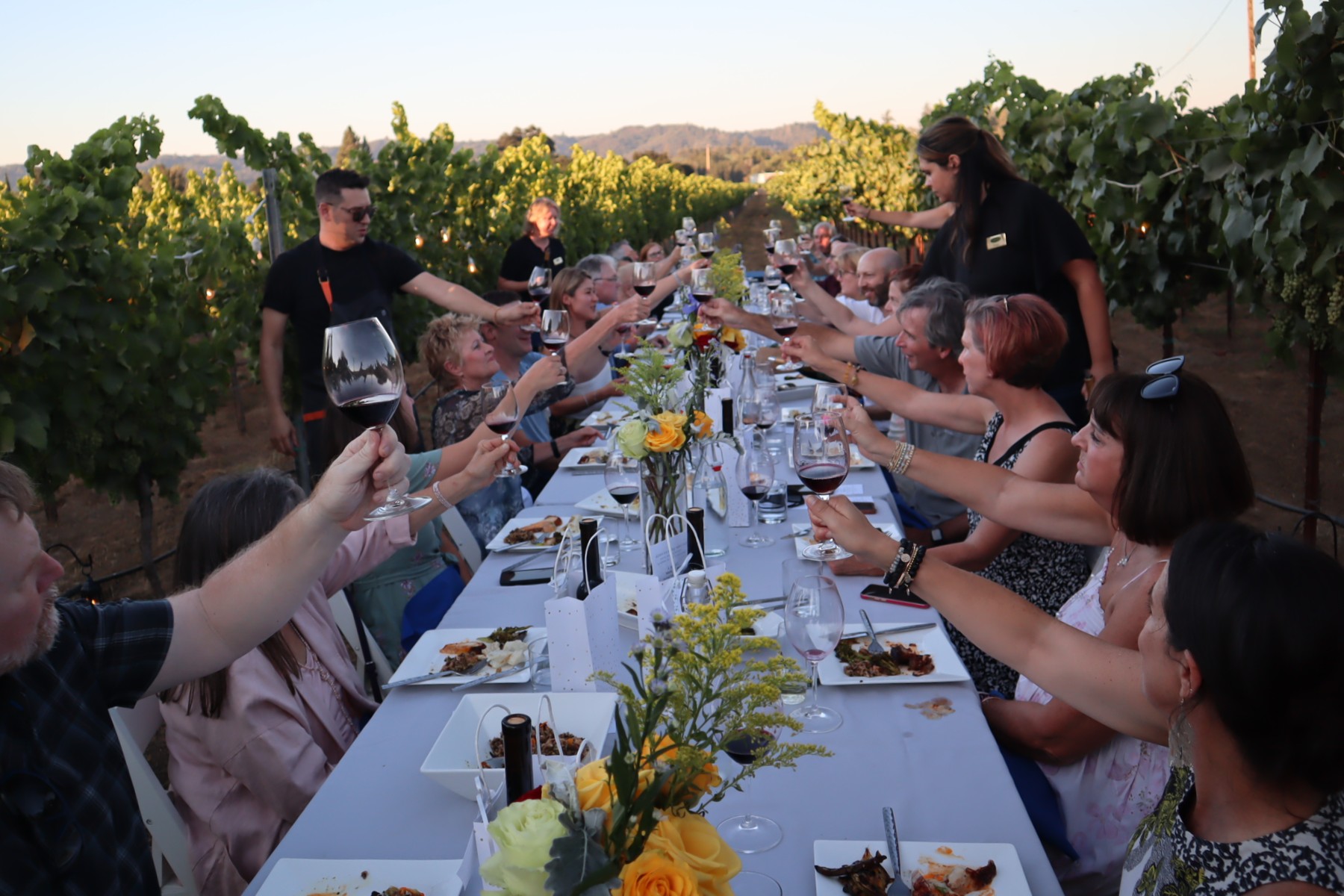
Friendship and Gratitude
Dinner in the Vineyard has always been a magical evening. This year was the first time that Mike was not able to join us. We drank a toast to him during dinner with his favorite wine, Tres.
I learned something very important that evening. I tried not to say much about Mike’s situation because it’s a festive occasion and who wants to hear about life’s trials and tribulations? And in fact, after a difficult day, sharing another amazing dinner among the vines with our guests lifted my spirits.
But I learned something more. I was touched when Jerry, a long-time club member, who makes the trip from Rhode Island each year, took the time during the vineyard walk to quietly ask, "How is Mike?" He genuinely wanted to know and didn’t seem to want just a cavalier “he’ll be fine” response.
Later in the evening, his wife Janie told me that they like to know about us and how we’re doing. She said that they feel more a part of the Amista family when they know what’s going on behind the scenes. During the fires, they appreciated our messages describing what was happening and they were relieved to learn we were not in the path of the fire.
So, for those who want to go behind the scenes, I will share more of the details of what our year has been like. Mike is currently in a rehab facility in Santa Rosa awaiting the replacement of his artificial knee. It’s been a rough year for him – a fall in mid-December where he wounded his knee, which led to a stay in the hospital over the holidays followed by two months of recovery at home with a 24/7 caregiver who moved in with us. It was necessary and needed but difficult for two introverts to share our small home with a stranger.
Just when Mike was able to get around on his own again, the wound on the knee became infected and he returned to the hospital at the end of March. He had surgery at Healdsburg Hospital where it was confirmed that the infection had gone to the bone and the artificial knee joint.
The artificial knee was removed and replaced with something called a spacer (basically cement) at UCSF, after which he spent 8 days in ICU to manage the sepsis infection. He was delirious for a few days and over a glass of wine I can tell you some hilarious stories! He returned to Healdsburg Hospital to complete six weeks of IV antibiotics and then transferred to a care facility in Santa Rosa. He is unable to walk because he cannot put any weight on the leg with the spacer.
The process has been much longer and more difficult than either of us imagined. The good news is that he finally has surgery scheduled on September 6 to get a new knee. He continues to get physical therapy while he awaits surgery, but it is limited since he cannot put any weight on the leg. He will return to the care facility for rehab, which will take longer than a typical knee replacement given his loss of muscle strength after spending so many months in bed.
Meanwhile, I have taken over full responsibility for our business – both the winery and vineyard – and our household, plus managing Mike’s healthcare (everyone needs an advocate to navigate the healthcare system) and driving to Santa Rosa to spend time with Mike each day. A bright light is that the dogs can visit him now that Torin has recovered from surgery and Dylan is improving after an injury to his leg during a frisbee run.
I am grateful that we have an incredible team led by Brian and an amazing winemaker and vineyard manager in Ashley and wonderful girlfriends who are there whenever I need something fun to do or a shoulder to cry on. And now I realize that there is a bigger community of Amista friends who are cheering us on. I’ll keep you posted.
With deepest gratitude,
Vicky
5 Surprising Facts About Grenache
All You Need to Know
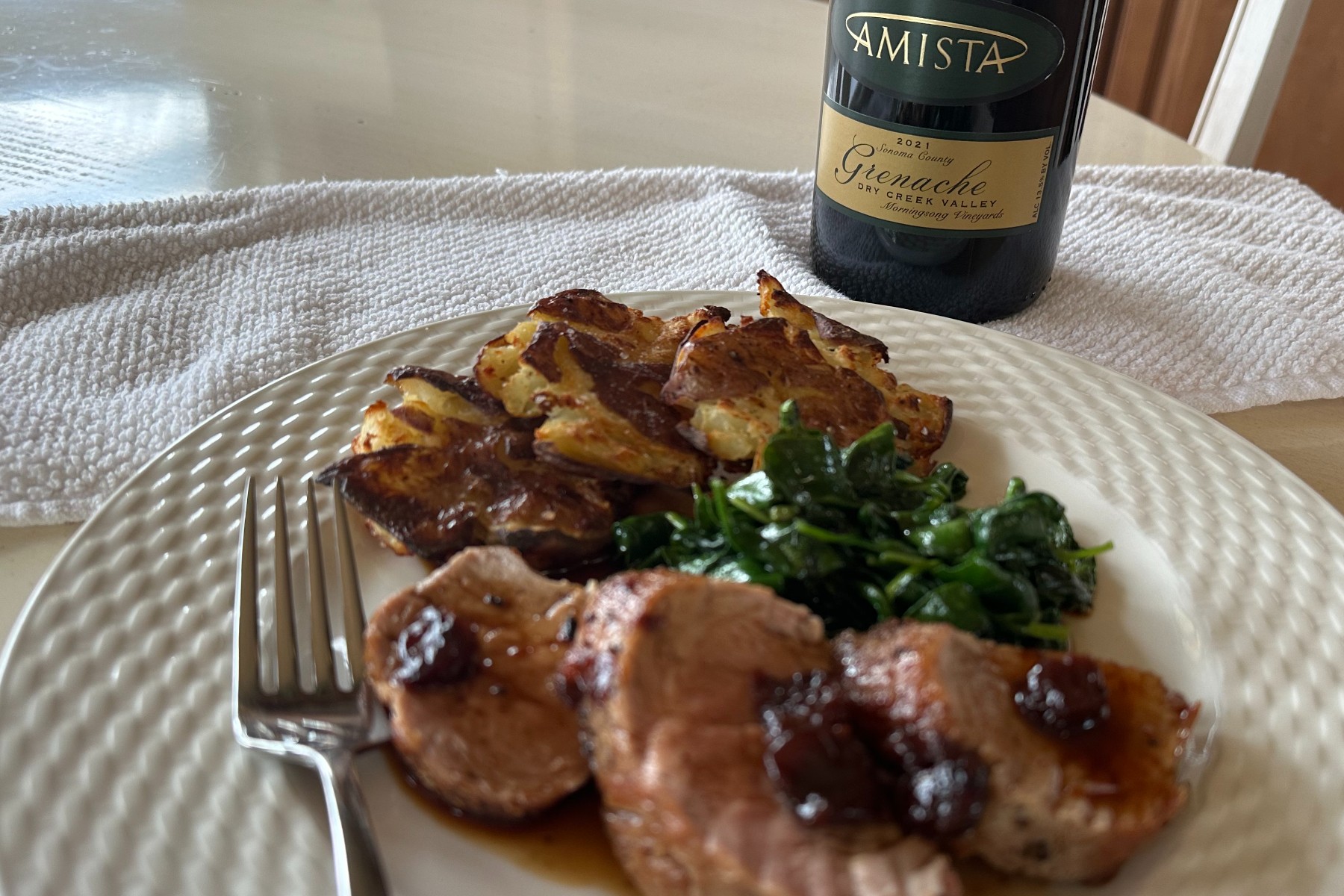
...plus a delicious Grenache pairing
Why care about Grenache, you might ask? Grenache has gained significant popularity and recognition in the world of wine. Its flavor profile appeals to a wide range of wine lovers and its medium body and medium tannins enable it to pair with a vast array of dishes and cuisines.
I have fallen in love with Grenache since we first added some to our estate vineyards in 2011. But what prompted me to write this post was a recent quote from a wine writer who attended the 40th anniversary celebration of the Dry Creek Valley AVA. Wine writer Mike Dunne proclaimed, “Forty years after federal authorities designated Dry Creek Valley an American Viticultural Area, the appellation’s signature wine has emerged – Grenache!”
That was music to my ears! We added our first Grenache vines despite the widely held opinion that Zinfandel was considered the signature grape in Dry Creek. I didn’t know much about Grenache then, but I knew I loved its medium body and that it was a great match for Mediterranean dishes, such as grilled meats, roasted vegetables, tapas, and even spicy foods – all the foods I love.
Pork tenderloin garnished with a raspberry balsamic sauce goes beautifully with Grenache. Add crispy smashed potatoes and sauteed spinach for a sensational taste experience.
5 Surprising Facts About Grenache
-
Grenache is the name in France; Garnacha is the name in Spain
-
Today Grenache/Garnacha is the 7th most planted grape in the world (5th among reds)
-
Grenache is one of the varieties in the renowned wines of the Châteauneuf-du-Pape AOC and has first billing in the trio of grapes that make up GSM blends (Grenache, Syrah, Mourvèdre)
-
Although often associated with France, it is widely agreed that Garnacha originated in Spain
-
Grenache is now referred to as a Rhône varietal, the world over
3 Interesting Tidbits about Grenache at Amista
- Today Grenache makes up 30% of the planted acres on our Morningsong estate vineyards
- Amista crafts the only Sparkling Grenache north of the Bay Bridge in California
- Grenache is used in seven of our Amista wines
Garnacha or Grenache?
Garnacha and Grenache are the same grape variety, known by different names in different regions. "Garnacha" is the Spanish name for the grape, while "Grenache" is the French name. The grape is believed to have originated in the region of Aragon in northeastern Spain.
While the grape variety itself is the same, there can be stylistic differences in the wines produced from Grenache depending on the terroir and winemaking techniques used in different regions. For example, Garnacha wines from Spain, particularly from regions like Priorat and Rioja, often exhibit a ripe, fruit-forward character with a touch of spiciness. Grenache wines from France, particularly from the southern Rhône Valley and Châteauneuf-du-Pape, can be more complex, showcasing a range of flavors including red and dark fruits, herbs, and floral notes.
A Widely Planted Wine Grape Variety
Although not as widely planted as Cabernet Sauvignon, Grenache/Garnacha is the 7th most planted grape in the world. Here are the top ten as of 2020 according to OIV (International Organisation of Vine and Wine).
Top grape varieties by planted hectares
1. Cabernet Sauvignon, 840,000 acres (340,000 hectares)
2. Merlot, 657,300 acres (266,000 hectares)
3. Tempranillo, 570,800 acres (231,000 hectares)
4. Airén, 538 700 acres (218 000 hectares)
5. Chardonnay, 518,900 acres (211,000 hectares)
6. Syrah, 470 000 acres (190,000 hectares)
7. Grenache Noir, 402,780 acres (163,000 hectares)
8. Sauvignon Blanc, 299 000 acres (121,000 hectares)
9. Pinot Noir, 285,000 acres (115,000 hectares)
10. Trebbiano Toscano / Ugni Blanc, 274,300 acres (111,000 hectares)
Grenache Plays a Starring Role in Châteauneuf-du-Pape
Grenache is one of the stars in the production of Châteauneuf-du-Pape wines and GSM blends. Châteauneuf-du-Pape is a renowned wine appellation located in the southern Rhône region of France. It is known for producing rich, complex, and full-bodied red wines that are highly sought after by wine enthusiasts around the world.
In Châteauneuf-du-Pape, Grenache is the dominant grape variety and is often the star of the blends. It thrives in the region's warm and sunny climate, where it can fully ripen and develop its characteristic flavors and aromas. It is accompanied by other varieties to create a harmonious and balanced wine. The most common blend, known as a GSM blend, consists of Grenache, Syrah, and Mourvèdre. Each variety brings its own unique characteristics to the blend, resulting in a wine with layers of flavors and a complex profile. The combination showcases a balance between fruitiness, spiciness, and structure. The wines are often full-bodied, with a silky texture, well-integrated tannins, and a long, lingering finish.
The Rhône Variety that Originated in Spain…or Italy
The origins of the Garnacha grape variety, also known as Grenache, have been the subject of some controversy and debate among wine experts and historians. While it is widely accepted that the Garnacha grape has Mediterranean roots, the specific location of its origin is still uncertain.
There are several theories regarding the origin of Garnacha. One theory suggests that Garnacha originated in the region of Aragon in northeastern Spain, where it has thrived for centuries, and it is home to some of the oldest Garnacha vineyards.
Another theory suggests that the grape may have originated in the region of Sardinia, Italy. Proponents of this theory point to genetic similarities between Sardinian grapes and Garnacha, as well as historical records that indicate the presence of Garnacha in Sardinia before it became widely established in Spain.
Grapevine cultivation and trade have taken place across the Mediterranean for thousands of years, making it difficult to pinpoint the exact origin of many grape varieties. Genetic studies have shed some light on the relationships between different grape varieties, but they have not definitively settled the debate about Garnacha's precise origin.
Today Grenache is Known as a Rhône Variety
Ironically today Grenache is known as a Rhône variety. This is due to its historical and significant cultivation in the Rhône Valley of southern France. The Rhône Valley is renowned for its production of red wines, and Grenache has been growing there for centuries. I wonder if it also due to the fame of Châteauneuf-du-Pape, which has no such rival in either Spain or Italy.
Still Thirsty?
If you want to learn more about Grenache, here is a curated list of resources.
Three Novel Ways to Celebrate National Wine Day
How about throwing a wine party with a new twist...
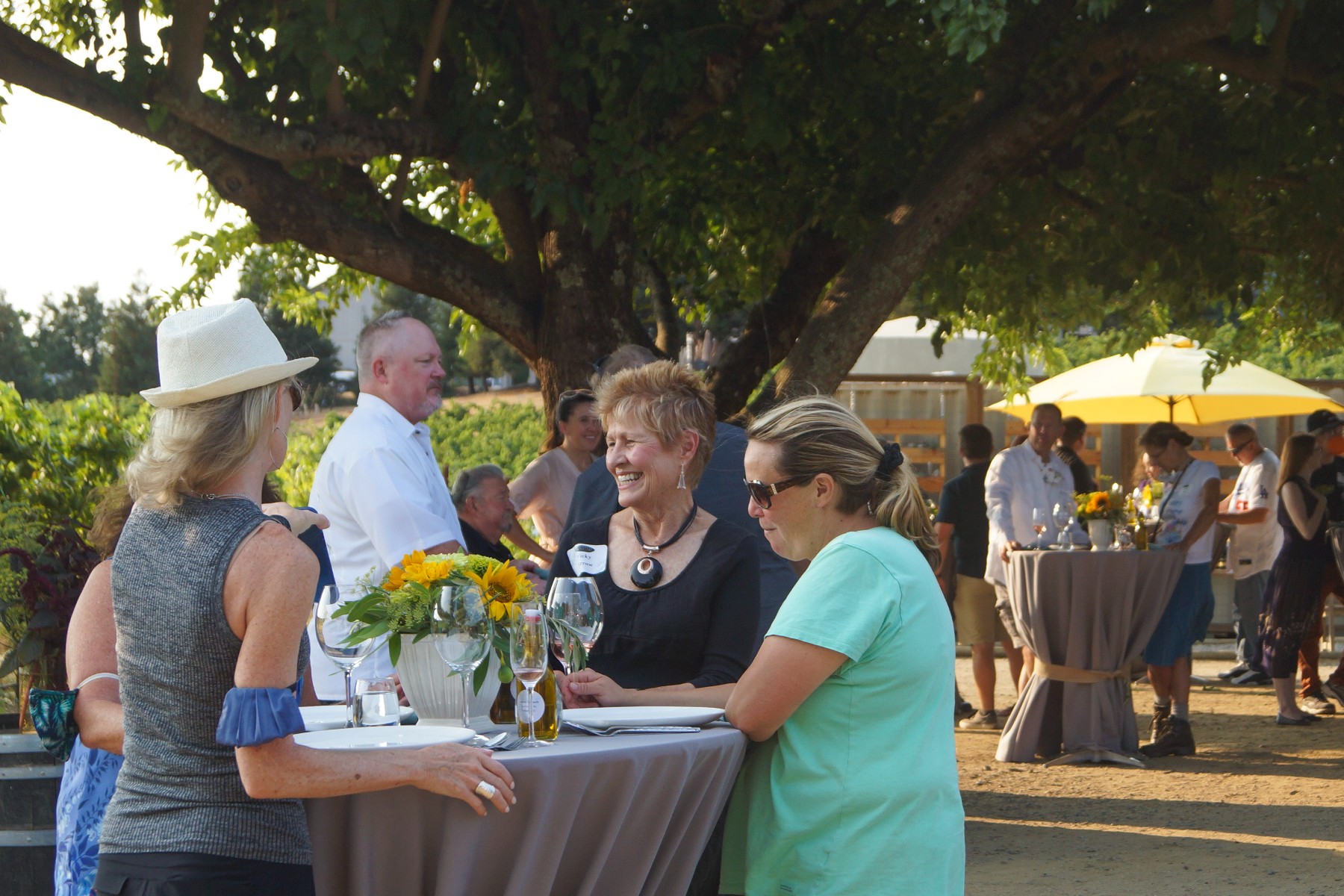
...that is sure to delight your wine-loving friends!
Did you know that National Wine Day is coming up this month on May 25? It is the perfect occasion to raise a glass to celebrate the exquisite flavors and aromas of wine. At Amista – which roughly translated means “making friends” in Spanish – we think the best way to celebrate is with friends. If you're looking for novel ways to commemorate this special day, here are three parties designed to explore the rich tapestry of wine with your special group of wine-loving friends.
Host a “You Aren’t Going to Believe This Great Wine I Found Party”
Gather your wine loving friends, family, or colleagues to celebrate National Wine Day by hosting a wine tasting party. But let’s kick it up a notch and ask each guest to bring an unusual wine they’ve discovered and come to love. It could be an obscure variety, an unusual style or from an unexpected part of the world. Each guest takes a turn telling the story of how they discovered their special wine and why they love it. Then everyone has a taste.
Such a party needs some equally interesting nibbles. Of course, there is the usual cheese and charcuterie spread, which is always welcome. But a “You Aren’t Going to Believe This Great Wine I Found Party” demands a twist. At Amista, we serve freshly popped popcorn. It’s so popular that when our popcorn machine broke one day, our guests went on strike.
We use a lemon-herb salt which showcases our sparkling Blanc de Blanc. To make it work for your party, assemble an assortment of at least a half dozen spice blends that can be sprinkled on the popcorn – a kind of popcorn bar. Choose a variety of blends that go with different wine flavor profiles. It’s novel, it’s easy and it’s fun to see what herbs and spices pair with each of the wines.
If I were going to the party, I would bring our Amista Sparkling Syrah. This wine never ceases to amaze people. Its cranberry color fools them into thinking it’s going to be sickly sweet and yet it’s quite dry – always Extra Brut (6 grams of sugar per liter or less). Also surprising is that it goes so well with diverse foods from Thanksgiving dinner to sushi to Peking duck. It even works with panna cotta and raspberry coulis! And the interesting tidbit is that we would never have made it if it weren’t for a class project at our local junior college.
If you want to create a delightful ambiance to celebrate National Wine Day, throwing a “You Aren’t Going to Believe This Great Wine I Found Party” will do the trick. The wines, the personal stories and the popcorn bar will provide a rich backdrop for exploring new wines, flavor combinations and conversations among friends.
Throw a “My Favorite Winery Party”
The invitation list for this party requires that your guests have a favorite winery they have visited in person. If you don’t have any friends who have visited a winery in person, I would say you need to make some new friends! But if you’re reading this blog post, you undoubtedly have friends who have gone wine tasting, so I’m assume you’re good to go. Invite them to celebrate National Wine Day with you by bringing any bottle of wine from their favorite winery.
Have each guest describe the wine they picked and why this is their favorite winery. Then everyone gets a chance to taste the wine. I suggest you start with the guests who brought sparkling wines, then whites, followed by rosés and then reds, from lighter to heavier in body, and ending with dessert wines.
It’s always good to have snacks when you’re tasting a lot of wine. It can be something very simple but tasty like bowls of kettle chips, popcorn, pretzels and nuts. You can also add a selection of cheeses, charcuterie and dried fruits.
If I was invited to such a party, I would proudly bring an Amista wine and it would have to be my go-to bubbly, our Amista Blanc de Blanc. This is the wine that marks the end of my workday and the beginning of my evening. It frequently continues as the wine that accompanies our dinner since we often have a fish dish or light pasta, which makes an amazing combination.
Hosting a “My Favorite Winery Party” allows your friends to share (and re-live) the wines and experiences they have savored on their wine journey. Celebrating wine is more than the wine itself. It’s the stories; it’s the experiences; it’s the landscapes; it’s the people that we remember when we visit a winery. Very often those moments are experienced with friends and create a lasting memory of shared happiness and joy.
Organize a “Bring Your Own Best Pairings (BYOP) Dinner Party”
National Wine Day presents an excellent opportunity to elevate your culinary experiences by pairing wines with delicious dishes. Whether your friends are seasoned chefs, enthusiastic home cooks, or discerning takeout experts, the versatility of wines allows for exciting pairings. Ask each guest to bring a dish and a wine that exemplifies their perfect pairing. You can assign hors d'oeuvres, first courses, entrees, sides and desserts. Or if you feel especially adventurous, you can leave it all to your guests and be prepared for a surprise!
Much like a winemaker dinner, have each guest describe their dish and the wine they chose for the perfect pairing before the dish is served. Hopefully there will be enough food and wine to try some of the dishes with different wines. Who knows, perhaps an even more perfect pairing will be discovered!
My perfect pairing would be a classic French cassoulet with our Amista Syrah. I adore beans – go figure - but when you combine them with chicken, duck confit and sausage and cook them slowly for hours with a crust of crispy breadcrumbs, well, I’m in heaven. And while I often describe our Syrah as a crowd pleaser, the perfect wine to take to a dinner party because it works with so many dishes, the cassoulet elevates it to a whole new level and vice versa.
The “Bring Your Own Best Pairings (BYOP) Dinner Party” is a unique variation on a classic winemaker dinner. It’s a way for everyone to channel their inner winemaker and inner chef and experience the varied tastes of a whole group of friends. What better way to celebrate the spirit of National Wine Day.
National Wine Day provides an excellent opportunity to appreciate the artistry of winemaking and the distinctive flavors of wines from around the world. Although seriously, there's no need to wait for a special day. You can choose any day to raise your glass and toast to the pleasures of fine wine, good food and dear friends. Cheers!
You're invited to explore the sparkling wines and Rhône varieties at Amista. We hope we'll become your new favorite winery. Come Taste With Us!
Does Color Matter in Sparkling Wine?
For the Fan Favorite, Sparkling Syrah...
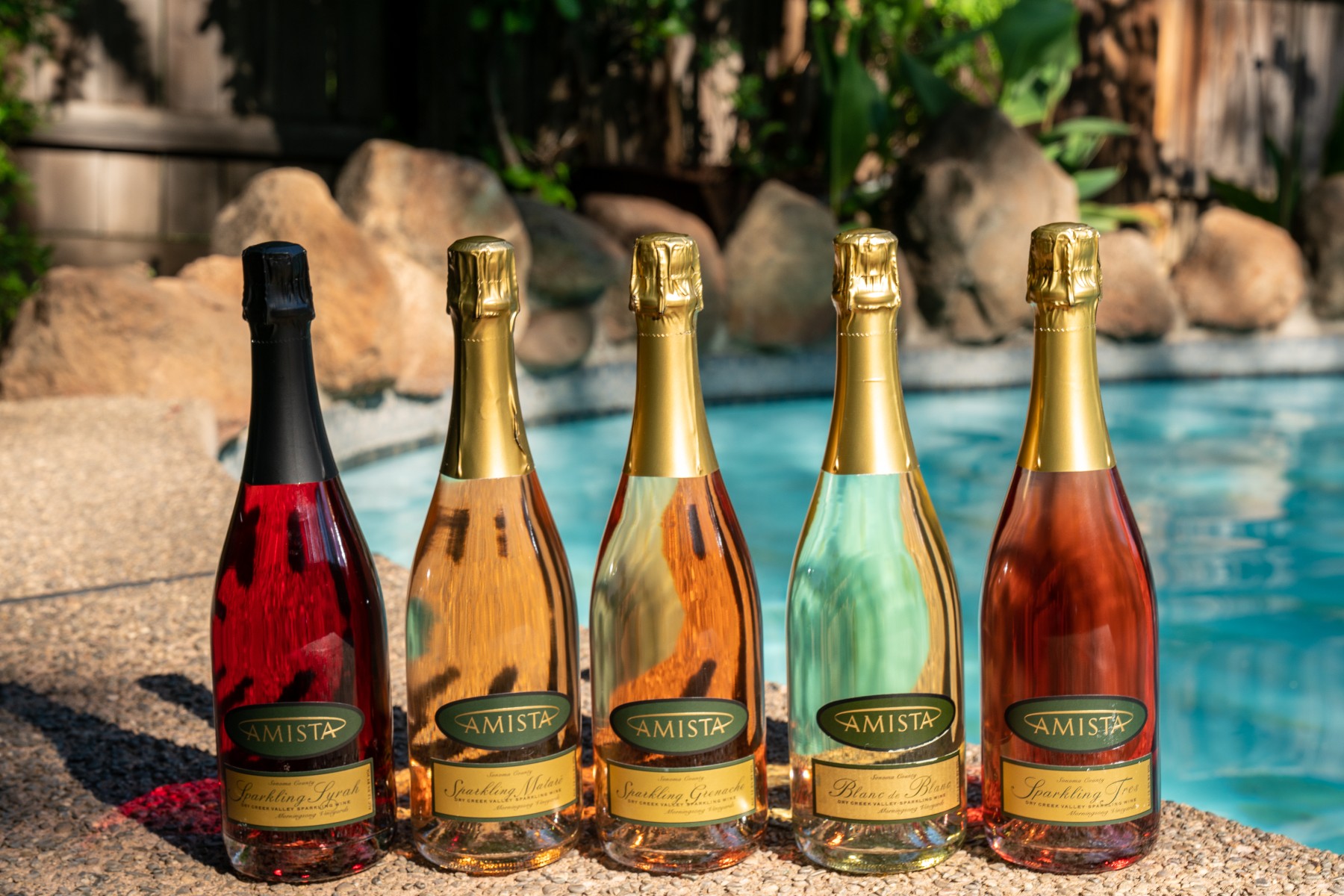
…will it be color or flavor?
Does Color Matter?
This is the question we went round and round about during our most recent dosage trial for our Sparkling Syrah. In fact, this was our second dosage trial for this wine because during the first trial, we all agreed that the color of the wine was too light. The colors of all our sparkling rosé wines vary a little from year to year. Nevertheless, the Sparkling Syrah is typically cranberry in color.
This Sparkling Syrah Was Not the Usual Cranberry Color
This one was more of a coral color. It’s beautiful in the glass and the flavors are delightful. It just looks different than what we or our members are used to. So, after our first trial, winemaker Ashley Herzberg decided to go back and try adding a small amount of still Syrah to the dosage. She brought a 1% and a 2% addition. We all liked the look of the 2% addition in the bottle. It was still a bit lighter than usual and leaned more toward coral than cranberry, but it was closer to the color we’ve all come to expect.
Always Cranberry, Except for the “Dark Year”
That was the 2010 vintage, before the other members of our team had joined us. Ashley, Mike and I remember it well. The “dark year” was alluring in the bottle but to our taste, it had just a little too much of the earthy flavor of Syrah. We love that flavor in the red Syrah. In our sparkling rosé we want a brighter, more fruit forward flavor.
But How Does It Taste?
OK, so back to the dosage trial. After seeing the colors of the two different additions in the bottle, it was time to pour and taste. We poured the 1% and 2% additions and looked at them side by side. In the glass, the differences in color were more subtle, although all of us preferred the color of the 2%. Now for the tasting. As soon as we tasted I got that hint of earthy Syrah in both samples. I didn’t want to say anything but then Ashley mentioned it. We decided we needed to go back and try the original without any added Syrah.
We were all blown away with how much fresher and fruitier it tasted, with bright bubbles on the tongue. The Syrah addition had weighed the wine down a little. The wind went out of our sails because we loved the taste of the original and preferred the color of the 2% addition.
What Do Our Customers Expect?
A lively discussion ensued about how much fun it is to do a tasting for our guests and start with a splash of our Blanc de Blanc, then proceed to one of the lighter rosés and then unveil the cranberry colored Sparkling Syrah. We call it “joy in a bottle” and it brings a festive note to, not only to a tasting, but to any occasion or dinner table.
Then we had an in-depth conversaton about our club members. We have many who have been members for years and they remember the colors of our different sparkling rosés. That is in part because all our sparkling wines are bottled in flint (clear) glass, so the color is visible. The other is that we have several rosés – many sparkling houses have only one. We’ve made a point to craft them so they each have a slightly different color. Now our members have come to expect that. Did something we featured come back to bite us?
Why Is It So Hard to Get a Specific Color?
From a winemaker’s perspective, achieving just the right color is no small feat. First, you don’t always have complete control of how much time the grapes stay on the skins, which is what imparts the color. Second, sometimes you get just the right color when you press the fruit and then it falls out when you disgorge the wine. You can adjust the color by adding some of the still red wine during the dosage, but that may change the flavor profile.
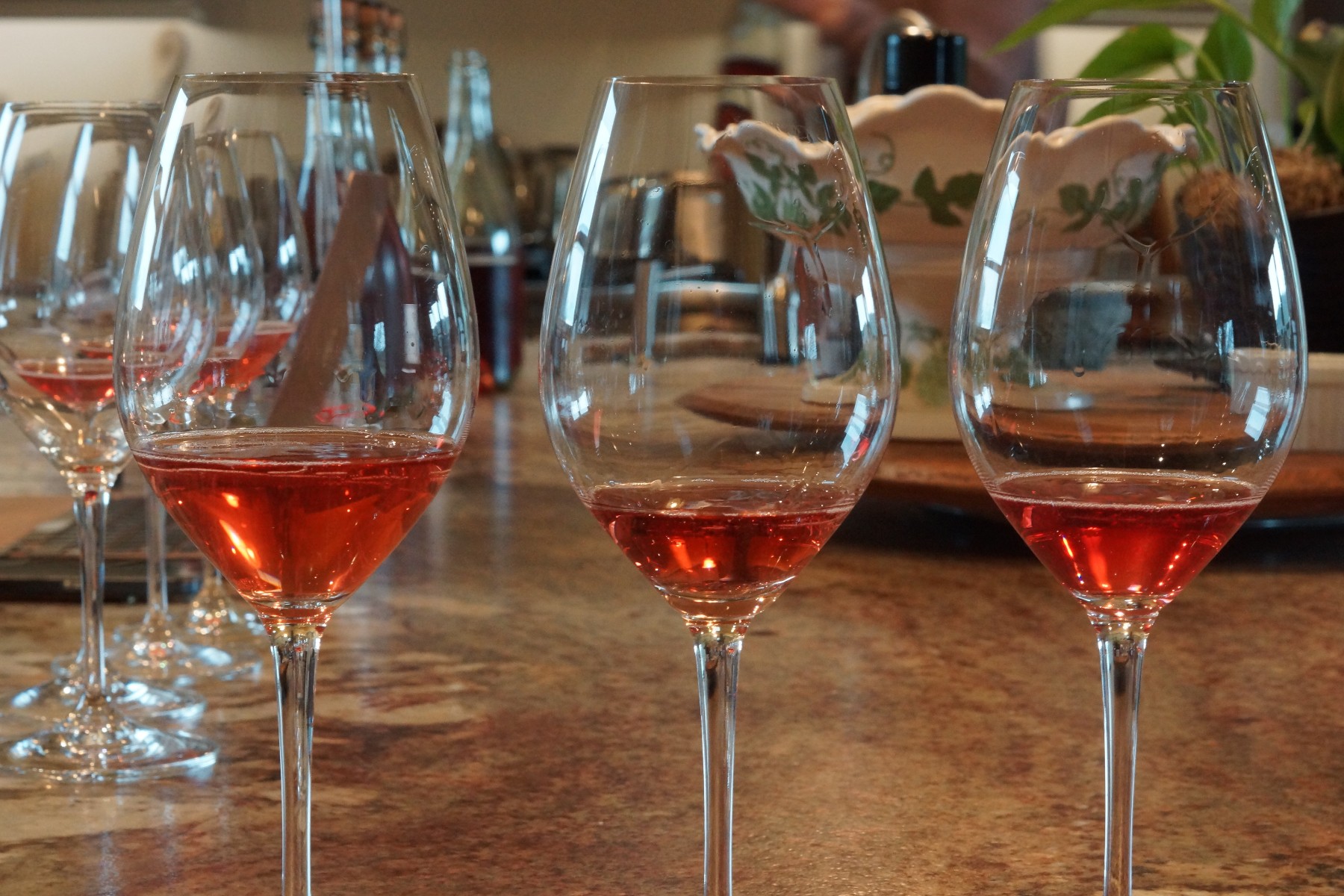
What Did We Decide – Color or Flavor?
It was unanimous. Taste wins over color. As much as we wanted the deeper, cranberry color, we just couldn’t sacrifice taste. Perhaps it’s not the cranberry color that makes our Sparkling Syrah “joy in a bottle”. I’m convinced that in a blind taste test, the joy would come from the bright, fresh picked strawberry flavors with a hint of citrus that bursts on the tongue.
Treat yourself to a little "joy in a bottle". Try our sparkling wines and Rhône varieties. Come Taste With Us!
Amista Owner Vicky Farrow Profiled for International Womens Day
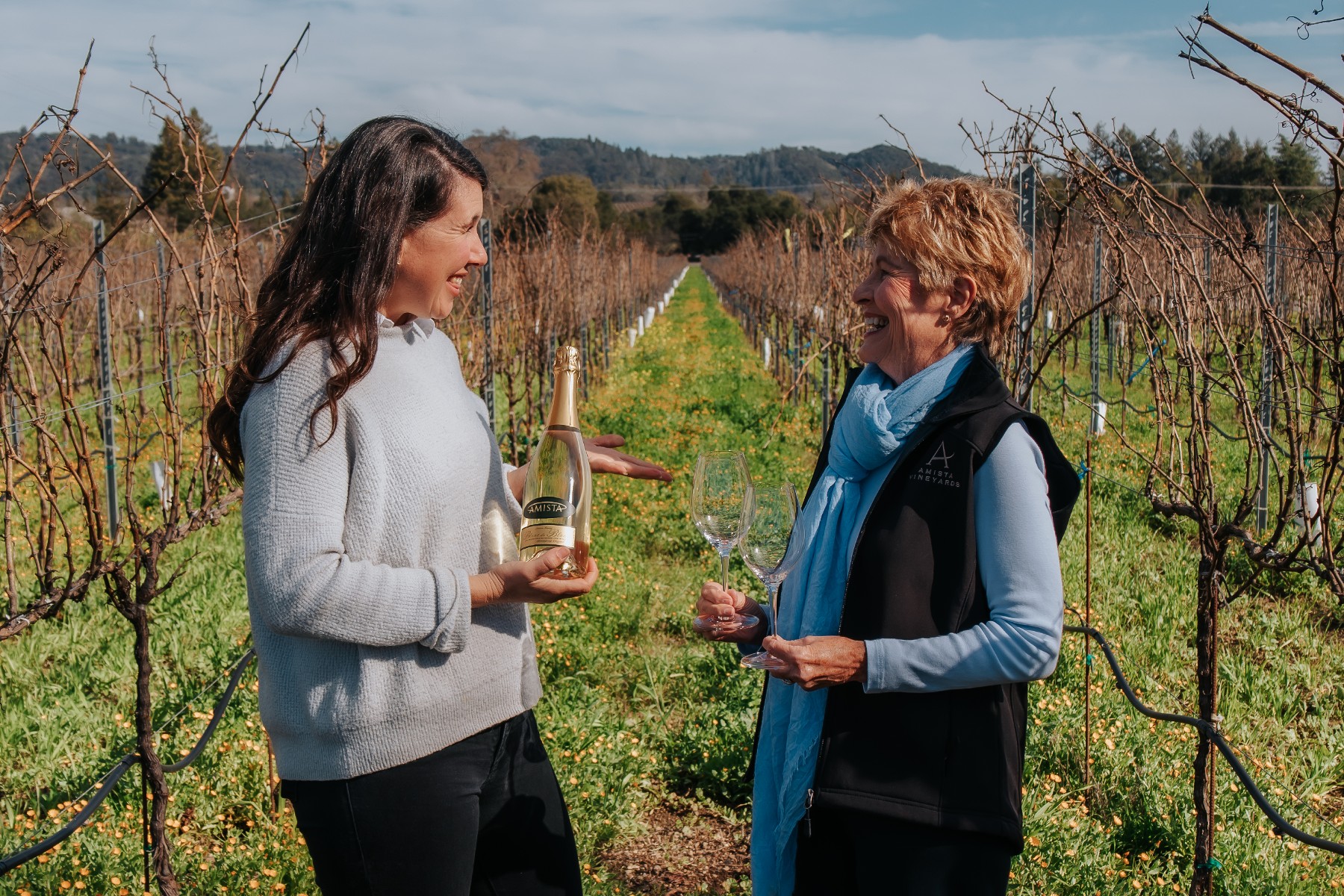
I am honored to be included in an article profiling women in wine for International Women’s Day, plus “the Wines We Are Toasting Them With” by Devin Parr. I’m even more excited to be toasted with a wine created by the women of Amista, our Blanc de Blanc.
A Sparkling Wine Created by the Women of Amista
What makes this wine extra special for toasting International Women’s Day is that it was created as the result of a spontaneous conversation between me and our newly hired woman winemaker, Ashley Herzberg, shortly after she arrived at Amista in 2011. We were standing in the Chardonnay vineyard one day and I asked her, “Do you think we could make a Blanc de Blanc from our Chardonnay?” She didn’t skip a beat when she answered, “Of course!” Mind you, she had not yet made a sparkling wine in her previous winemaking career. But, like me, she loves bubbles. Plus, Ashley is a woman who loves to learn and is always up for a new challenge.
Her First Sparkling Harvest
That fall, Ashley did her first harvest specifically to make a sparkling wine. She picked the grapes earlier than she would for a still wine to achieve lower sugar levels and thus lower alcohol, and higher levels of acid. She was nervous about how to know when the grapes would be ready to pick.
She got some sage advice from another woman winemaker, Penny Gadd-Coster, who had been making sparkling wines for over a decade. Penny told her, “You just still pick for flavors. You're shifting what you're looking for in those flavors. But you're still picking for flavors.” Ashley did just that and the inaugural release of our Amista Blanc de Blanc in 2013 scored 91 points and won a gold medal in the Press Democrat’s “Best of the Best” North Coast Wine Challenge.
Women Making Progress in Wine
As we toast to women in wine on International Women’s Day it’s worth celebrating that “Women have long been making strides in wine and, although the work is by no means done, it’s an exciting time to be a woman in the industry,” says Parr. She’s right.
A lot has changed over the years for women in wine. I have had the privilege of talking with several women involved in making sparkling wine as part of my project Sparkling Discoveries and there is a clear difference in the experiences of the young women of today as compared with the women who began their careers over two decades ago.
The trailblazing women who started their careers back then were consistently told they could not be winemakers because the work was too difficult for women. In my conversation with Eileen Crane, founding winemaker at Gloria Ferrer and Domaine Carneros, she told me that the first professor she met when she was exploring a degree in enology at Davis told her she couldn’t be a winemaker because she wouldn’t be able to do the work in the cellar. “You can’t handle the barrels,’ he told me. He suggested I finish my PhD in nutrition. I told him I’m not going to be doing that. I’m going to be a winemaker.” It took courage and determination to challenge such attitudes.
Today’s Challenges for Women in Wine are Different
The younger women working in wine today no longer face that kind of active opposition. Women are being encouraged to go into winemaking and wine business. They are celebrated, honored and recruited.
Challenges remain however, although they are less blatant. One has to do with the automatic assumption that the man is the winemaker or CEO. When a man and a woman are both pouring at a tasting, the questions about winemaking are typically directed to the man, although that appears to be changing. Kathleen Inman, Owner and Winemaker at Inman Family Wines, says, “I’ve noticed that people are less surprised to find out that I’m the winemaker, and not my husband, than they were 10 years ago.”
The other two challenges are pay equity and the presence of women in the most senior positions in wine businesses. A 2020 study by Wine Business Monthly shows 28.8% of the wineries had a female as Winemaking Director, although the average of the salaries for those females was 8% lower than the average for males. The same study shows 22% of winery CEOs were female but total cash compensation of the men was nearly double that of the women (1.95 times greater).
Inspiring Stories of Today's Women in Wine
So yes, there is still work to do. That is why it’s inspiring to read about examples of women with “extraordinary talent in wine” as described by Parr, and to hear what embracing equity means to each of them.
Read “15 (or so) Women We Are Toasting This International Women’s Day…And the Wines We Are Toasting Them With” by Devin Parr.
A Toast to Ashley Herzberg Next Generation Winemaker from Amista
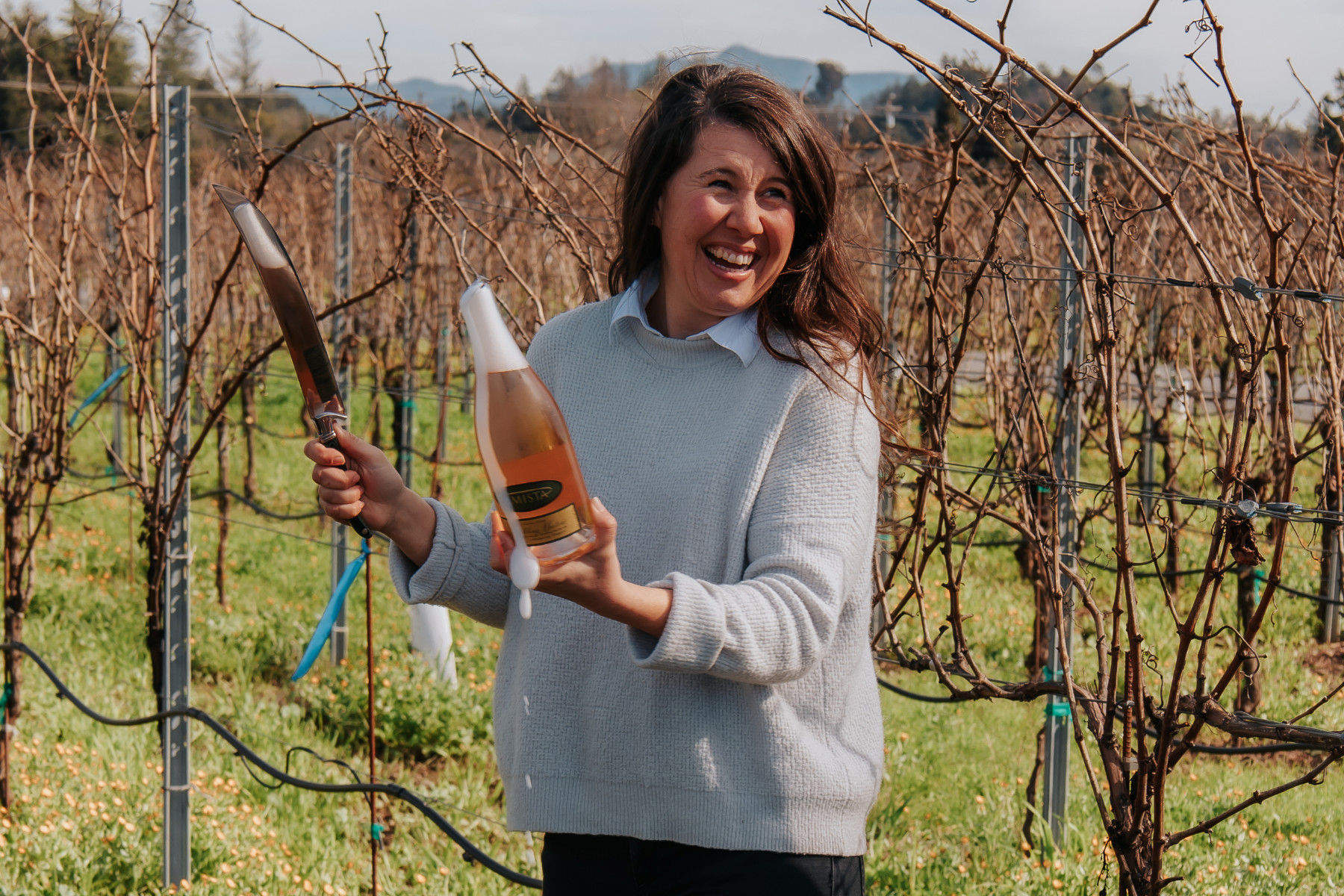
“As the consulting winemaker for Amista Vineyards and Cast Wines, Ashley’s talents have produced many memorable wines. If you haven’t tried the Amista sparkling wine collection, be sure to stop by soon,” writes Rebecca Germolus in her article “A Toast to Women Winemakers.”
“In honor of Women’s History Month, let’s explore the paths of a few women winemakers along the Wine Road,” adds Germolus. If you are familiar with Sonoma County wine, you’ll know the names of the three women she features as pioneers, Carol Shelton, Julia Iantosca and Phyllis Zouzounis. Not only do they craft amazing wines, but they truly have been part of blazing the path for a future generation of women winemakers in Sonoma County. Rebecca proposes a toast to these pioneering women, saying, “A big thank you to Carol, Julia and Phyllis for staying the course.” We couldn’t agree more.
We are thrilled that Ashley is recognized as one of the next generation women shaping winemaking in Sonoma County. She is in good company on this list of other extremely talented female winemakers. She knows and interacts with all these women. That is one of the most wonderful things about Northern Sonoma County. There is a sense of connection, mutual support and admiration that permeates our wine community. By the way, men are not excluded, although I suspect the bond with other women is something extra special.
One of the ways Ashley stands out is making sparkling wines. Only a handful of winemakers in Sonoma County can make that claim plus Ashley is equally talented at crafting still wines. Her focus at Amista is on creating elegant, approachable sparkling wines from varieties that are not traditional - Rhône varieties - though she uses the traditional method, the same process that is used to make French Champagne. She is currently making six sparkling wines for Amista, all grown in our estate vineyards, and has another fermenting in the bottle to be released in 2024 to celebrate our 20th anniversary.
If you haven’t tried her sparkling wines or need to treat yourself again, we invite you to Taste With Us and toast to the women winemakers along the wine road.
Read “A Toast to Women Winemakers,” by Rebecca Germolus.
Celebrating Sparkling Women in History
From Veuve Clicquot to Amista’s Ashley Herzberg
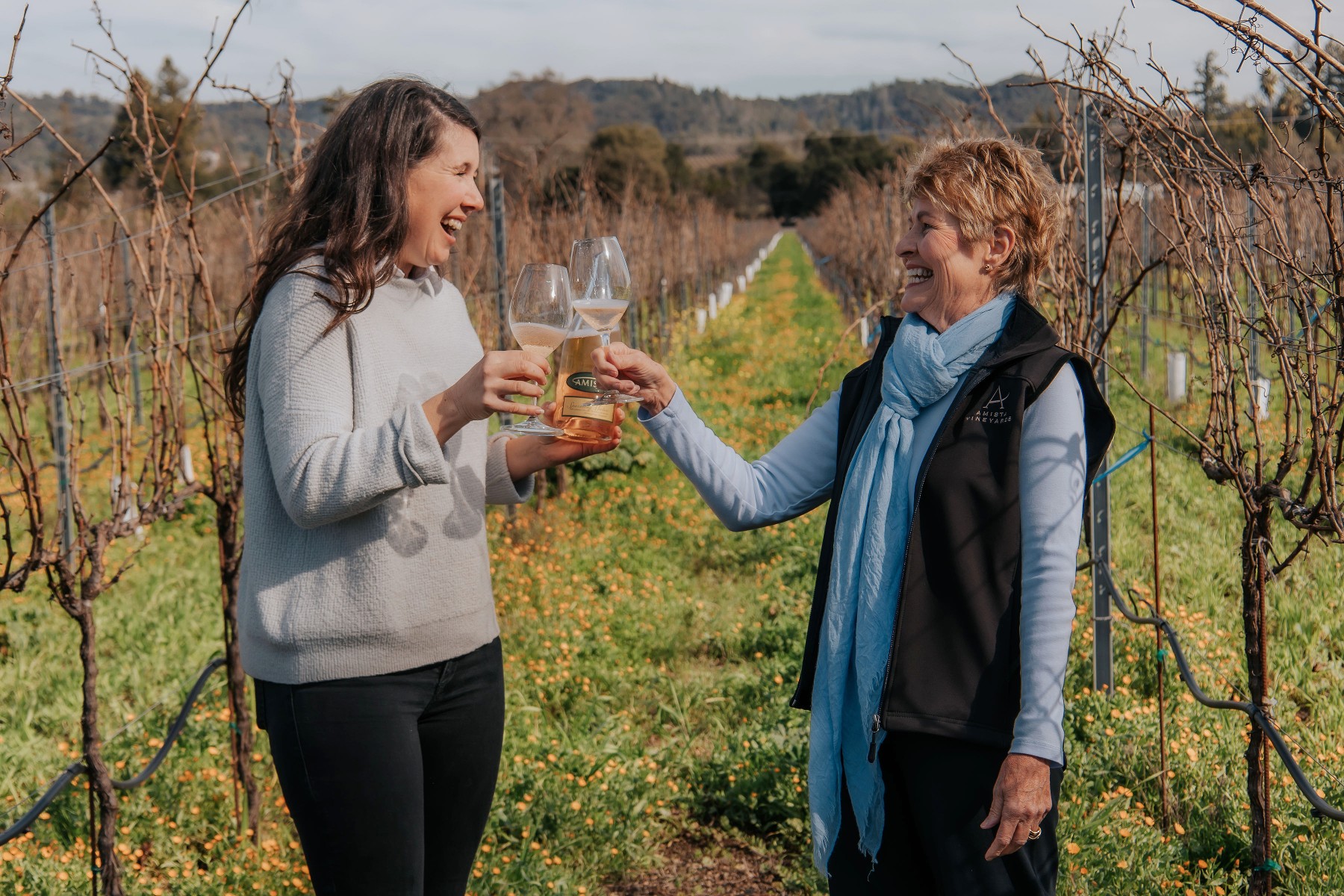
…a toast to the women of sparkling – past and present
I just read an excellent article titled “How three widows came to rule Champagne” about the women who created some of Champagne’s most lauded empires. Although women were restricted from owning a business without the permission of their husband or father in 19th century France, widows were exempt from this rule.
Female Ingenuity in Champagne
“Some of the biggest innovations of Champagne came down to the ingenuity of several women…Barbe-Nicole Clicquot-Ponsardin, Louise Pommery and Lily Bollinger – among others – to turn vineyards into empires and ultimately transform the Champagne industry, permanently changing how it's made and marketed,” writes Lily Radziemski in BBC.com's World’s Table.
Bold Actions by Three Widows
It is good to be reminded of some of the bold actions of these three Champagne widows such as running the blockade into Russia to beat her biggest competitor to market before the borders opened, dramatically reducing the dosage (residual sugar) in her Champagne from the typical 300 grams per liter to what is now called Brut (12 grams or less) to appeal to the British market, or traveling alone across the U.S. to hand sell her Champagne to the American market.
Drawing Inspiration from Women's History Month
I’m inspired by these women who ignored what was considered acceptable for women at the time and daringly stepped in to manage and ultimately transform the businesses they inherited. “The independence and creativity of the three widows paved the way for generations of women to come,” explains Radziemski.
Paving the Way for Today's Women in Sparkling
The conversations I have with women leaders in sparkling wine prove her point. I continue to be inspired by the women who are blazing new trails in today’s business world. I enjoy the great privilege of having in-depth conversations with some of today’s female leaders in sparkling wine through my new project, Sparkling Discoveries. [We include men as well, but given that March is Women’s History Month, my focus is on women in this post].
Eileen Crane was hired as the winemaker for Gloria Ferrer, the first sparkling winery in Carneros, and discovered that in addition to making the wines, she would be responsible for constructing the winery and visitor center and launching the new brand. She went on to lead Domaine Carneros, starting one of the first wine clubs, pioneering the installation of solar at a winery and practicing “open book management.”
Penny Gadd-Coster became a sparkling winemaker after two previous careers – one in research and the other in hospital emergency rooms. She was told countless times that she could never become a winemaker because, “People didn’t think women should be in the cellar. The work was too physical,” explains Penny. She went on to be the Executive Director of Winemaking at Rack and Riddle, a custom wine services operation that produces wines for hundreds of sparkling wine houses.
Joy Sterling, owner of Iron Horse Vineyards, had a successful career in broadcast journalism until on her 10th anniversary she abruptly quit her job and moved to Sonoma County with no plan and no experience, to join her family’s sparkling wine business. She has become a master at creating new sparkling wines, often contributing part of the proceeds to causes that are dear to her heart such as the Marine Mammal Center (Ocean Reserve) and Redwood Empire Food Bank (Gratitude).
And speaking of close to the heart, I am fortunate to work alongside our woman winemaker at Amista, Ashley Herzberg, for the last 12 years and counting! She a trailblazer when it comes to winemaking, being the first woman to make a “grower sparkling wine” in Dry Creek Valley. She also manages to juggle being a busy winemaker, harvesting from multiple vineyards, working in several production facilities, making still and sparkling wines and attending numerous wine events, with being a dedicated mom to her two children. I am especially inspired by how she weaves together her work, her family, her friends and her community into a seamless life of constant learning, passion and delight.
Ashley and I are honored and proud to be part of a growing community of wineries in Sonoma County that are female led with female winemakers.
Read “How three widows came to rule Champagne”
Check out more Sparkling Conversations with other interesting people from the world of sparkling wine.
